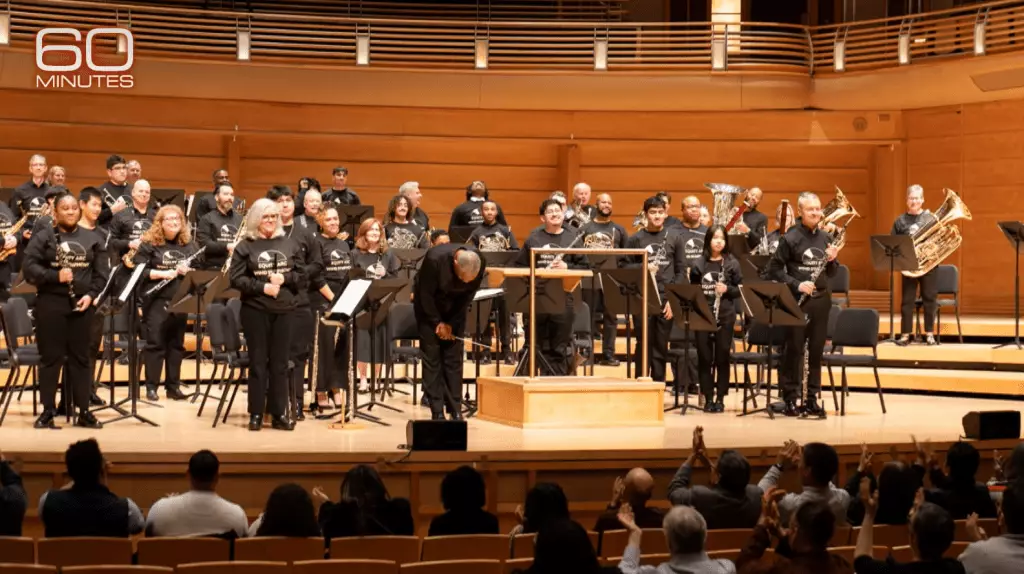In a world that prides itself on diversity, it is alarming to see the systematic dismantling of programs that celebrate and promote it. The recent episode of 60 Minutes, which scrutinized President Trump’s executive order against diversity, equity, and inclusion (DEI) initiatives, highlighted the adverse effects of this political shift on young artists from marginalized communities. One vivid example involves a group of talented musicians—young Black, Hispanic, Indian, and Asian individuals—who were unjustly denied the opportunity to perform alongside the prestigious U.S. Marine Band due to this harmful executive order.
The Marine Band, an institution steeped in history and tradition, had previously joined forces with a nonprofit organization called Equity Arc to create pathways for these promising musicians. The intent was clear: to allow students from diverse backgrounds to connect with professional musicians and showcase their talents in a collaborative concert. This was not just an opportunity for personal growth; it was a vital step towards inclusivity in a field historically dominated by a homogeneous demographic. Yet, with the stroke of a pen, those hopes were dashed.
Art as a Reflection of Society
Rishab Jain, an ambitious 18-year-old musician and one of the selected students, poignantly articulated the broader implications of this exclusion. He underscored that the suppression of artistic expression is often a reflection of societal fears and vulnerabilities. When a society silences certain voices or art forms, it effectively stifles not just creativity but the deeper emotional undercurrents that bind humanity together. The inability to express a full spectrum of human experiences through music is, in Jain’s words, an act of “devaluing our own humanity.”
This sentiment resonates beyond the realm of music; it speaks volumes about the values we uphold as a society. Does the Trump administration fear what diverse perspectives might unveil about the American identity? The question lingers in the air as the impacts of such policies ripple through the lives of young artists striving not only for individual expression but for the representation and validation of their communities.
The Wake of a Cultural Shrift
Ironically, the episode of 60 Minutes aired amidst its parent company’s own retreat from DEI policies, creating an unsettling juxtaposition. The concert organized by 60 Minutes, featuring both youth musicians and retired military band members, represented not just a stand against these exclusionary practices but an affirmation of the importance of inclusivity in the arts. Conducted by Rodney Dorsey from Florida State University, the performance showcased a rich tapestry of talent that is not usually seen within traditionally white-dominated orchestras.
John Abbracciamento, a retired Marine Band musician, articulated the heart of the matter: the concert did not threaten the fabric of the United States; rather, it celebrated its diversity. His challenge to critics—the call for anyone to argue that such an event would do damage—pinpoints the absurdity of equating meritocracy with exclusion.
Districts of Creativity
The imbalance in representation within American orchestras—where 80% are white, with staggeringly low statistics for other races—remains an open wound in the cultural landscape. The refusal to include diverse voices impoverishes the artistic dialogue and robs society of the multi-faceted narratives that come from varied experiences. The voices of marginalized communities are often drowned out by a narrative that favors the status quo, leaving an unfilled void in the musical dialogue of America.
The work of Equity Arc in promoting diversity in orchestras is not just about numbers; it is about enriching the nation’s artistic voice. It aims to create a space where young musicians feel seen and acknowledged. To dismiss these initiatives as mere social engineering is not only shortsighted but also damaging to the fabric of cultural exchange in our increasingly interconnected world.
As the concert brought together a unique assembly of talents, it also serves as a reminder of the resilience of the human spirit. The persistence in the face of such bureaucratic roadblocks is a testament to the dedication of these young musicians and their mentors, highlighting the collective commitment to a more inclusive future for the arts. The reverberations of their music echo the call for action against a system that threatens to suppress not just art, but the essence of humanity itself.


Leave a Reply